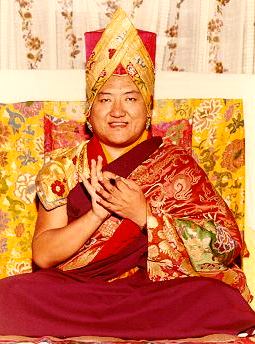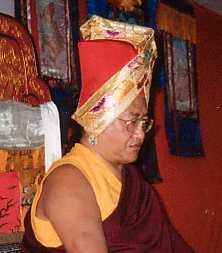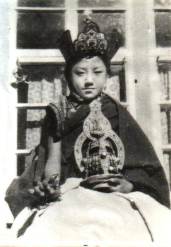|
| ||
|
| ||
| |||||||||||
 |
|
|
His Holiness Sakya
Trizin Ngawang Kunga was born in Tsedong near Shigatse in
the Sixteenth Rabjong cycle, in the year of The Wood Bird, on
first of the eighth Tibetan month (September 7, 1945).
Ngawang Kunga Rinchen, the previous head of the
Dolma Phodrang, and Sonam Drolkar, the sister of a renowned minister of
the Tibetan government, had four children. The eldest, a daughter whose
name is Jetsunma Chime Luding, currently lives and teaches in Canada. The
next born were a son and daughter who passed away in infancy. "They urged my parents not to give up hope, and moreover they gave up one of their best teachers, Lama Ngawang Lodro Rinchen, so that he could travel with my parents. This was something of a loss to the monastery, but he was a very powerful Lama who could perform all the different rituals, and in particular, his prayers had caused children to be born to women who had been unable to have children before. After his he always travelled with my father, and together they performed many rituals and prayed for a son to be born. At last it became clear that the prayers had been answered and my parents halted at Tsedong, a small, pleasant town near Shigatse. It had been decided that it was a good place for a child to be born, partly perhaps for its reputation as the birthplace of many great Sakya teachers such as Ngachang Chenpo Ngawang Kunga Rinchen. In fact, I was born in the same room as Ngachang Chenpo. A further problem arose: a succession of astrologically inauspicious days. As my parents wanted me to be born on an auspicious day, many more prayers were said. And I was not born on a bad day: I was born on the first day of the eighth Tibetan month, which was considered quite good. It is said that rainbows were seen over our house, and that an image of Guru Rinpoche was then offered to my father, which were good signs, but of course, I didn't know anything of this." Immediately after Sakya Trizin was born, birth,
the sacred syllable letter Dhih (the letter of Manjushri) was written on
his tongue with a special nectar made of saffron and many other things.
While he was an infant, his name was Ayu Vajra. Later, when his father
gave him his first major initiation of "The Nine Deities of Amitayus" he
was given his present name Ngawang Kunga Thegchen Palber Thrinley
Samphel Wangyi Gyalpo. When the family returned to the
main Sakya monastery the next year, there was an extensive celebration of
the anniversary of his birth. | |
 |
 |
|
Early childhood and
education In 1951, His Holiness Sakya Trizin made a pilgrimage to Lhasa. There at the age of six he was designated the throne holder of the Sakya Order by His Holiness the Dalai Lama. Accordingly, the next year a preliminary enthronement ceremony was performed in which he accepted the official seals of the office of the Sakya Trizin. Following the Parinirvana of His Root Guru Ngawang Lodro Zhenpen Nyingpo in 1953, the latter's Regent, Ngawang Tenzin Nyingpo, became another important guru to him. From this lama he received the initiations and reading tranmission (lung) for Grub-thab Kun-tu (The Collection of Sadhanas). And from Lama Ngawang Lodro Rinpoche he received the initiations and oral instructions relating to the Marpo Kor Sum (Three Major Red Deities), the Marmo Kor Sum (Three Red Deities), and the two main Sakya Protectors. At the age of eleven he again journeyed to Lhasa where he received teachings from His Holiness the Dalai Lama at the Potala Palace. Also on this occasion he gave an extensive explanation of the Mandala Offering before the Dalai Lama and a large assembly. This event led to his wisdom being proclaimed throughout Tibet. Another guru to His Holiness was the renowned Lama Jamyang Khyentse Chokyi Lodro, from whom he received many Tantric initiations and teachings, both Sakya and Nyingma. In 1957 he again received the Lam Dre teachings, on this occasion from the great abbot of Sakya, Vajradhara Jampal Zangpo, according to the tradition of the Khon Lineage transmission. Fleeing Tibet for religious freedom and preserving the Buddhadharma
Abandoning the holy
principal seat of the Sakya tradition, which his family had occupied for
nearly 900 years, His Holiness was able to take with him only the barest
minimum of possessions and a few attendants. Arriving in India in 1959 at
the age of fifteen, he was nonetheless able to found Ghoom Monastery at
Darjeeling in the following year, and Sa-Ngor Chotsok Monastery at Gangtok
in Sikkim and also to begin the task of reassembling the Sangha.
On account of political tensions between India and China during the early 1960s which were giving rise to military activity in the border regions, His Holiness then moved from Darjeeling to the relative safety of Mussourie in the Himalayan foothills near Dehra Dun. Around this time he taught the Lam Dre Tshod Shey at Varanasi. The Central Institute of Higher Tibetan Studies, a Tibetan Buddhist university, had recently been established at nearby Sarnath, and this was a time for regrouping and re-establishing of contacts for many Tibetan people who had been scattered and separated by the traumatic events of recent years. His Holiness, His Eminence Chogye Trichen Rinpoche (head of the Tsarpa branch of the Sakya Tradition and of Nalendra Monastery), and His Eminence Ngor Luding Khen Rinpoche (75th abbot of Ngor Monastery) were all present. This event was seen by many as a watershed, after which a new blossoming of Dharma activity came about. Marriage and maintain the tradition of the Khön
Lineage Later, in January 1988,
on the anniversary of the parinirvana of Sakya Pandita, His Holiness
consecrated and inaugurated the monastery and temple of Ngor E-wam Choden
at Manduwala, near Dehra Dun. Meanwhile larger permanent premises for
Sakya College (referred to earlier) had been built at Rajpur, and by the
present time it caters for 130 monks, producing twelve graduates each
year. | |
![]()
|
copyright ©
Simhanada . All rights reserved. Reproduction by permission only. |